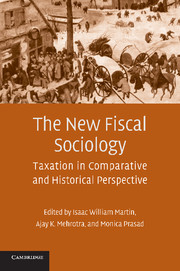Book contents
- Frontmatter
- Contents
- List of Contributors
- Acknowledgments
- Foreword
- 1 The Thunder of History: The Origins and Development of the New Fiscal Sociology
- PART ONE SOCIAL SOURCES OF TAXATION: AMERICAN TAX POLICY IN COMPARATIVE PERSPECTIVE
- 2 “The Unfair Advantage of the Few”: The New Deal Origins of “Soak the Rich” Taxation
- 3 What Americans Think of Taxes
- 4 Read Their Lips: Taxation and the Right-Wing Agenda
- 5 Making Taxes the Life of The Party
- PART TWO TAXPAYER CONSENT
- PART THREE THE SOCIAL CONSEQUENCES OF TAXATION
- References
- Index
2 - “The Unfair Advantage of the Few”: The New Deal Origins of “Soak the Rich” Taxation
Published online by Cambridge University Press: 13 January 2010
- Frontmatter
- Contents
- List of Contributors
- Acknowledgments
- Foreword
- 1 The Thunder of History: The Origins and Development of the New Fiscal Sociology
- PART ONE SOCIAL SOURCES OF TAXATION: AMERICAN TAX POLICY IN COMPARATIVE PERSPECTIVE
- 2 “The Unfair Advantage of the Few”: The New Deal Origins of “Soak the Rich” Taxation
- 3 What Americans Think of Taxes
- 4 Read Their Lips: Taxation and the Right-Wing Agenda
- 5 Making Taxes the Life of The Party
- PART TWO TAXPAYER CONSENT
- PART THREE THE SOCIAL CONSEQUENCES OF TAXATION
- References
- Index
Summary
When he arrived at the White House in 1933, Franklin Roosevelt inherited a regressive tax system. Excise taxes – most levied on consumer goods – provided more than half of all federal revenue in fiscal year 1933. “It seems to me that our national anthem should begin with the words, ‘Oh, say, can you pay?’” complained a writer for the Saturday Evening Post. “And so far as I am concerned, Yankee Doodle comes to town a-riding on a vacuum cleaner” (Phillips 1935: 27).
Leaders of the Roosevelt administration lamented this regressive system, but they didn't do much to change it. For the first two years of his presidency, Roosevelt ignored calls for progressive tax reform. In fact, the New Deal's first important tax innovation was a highly regressive food tax, enacted as part of the Agricultural Adjustment Act of 1933. However, in the summer of 1935, Roosevelt changed course, asking Congress for a range of new taxes on rich individuals and large corporations. Such measures were vital, he declared, to safeguard the nation's ideals as well as its economy. The growing concentration of wealth and economic power posed a serious threat to American democracy, even as it hindered economic recovery.
Compliant lawmakers gave FDR much of what he wanted, but not before a bruising battle with business groups. Indeed, business leaders were vigorous, voluble, and very nearly unanimous in their opposition to Roosevelt's tax plan. Some objected to specific provisions, defending the interests of a particular industry or company.
- Type
- Chapter
- Information
- The New Fiscal SociologyTaxation in Comparative and Historical Perspective, pp. 29 - 47Publisher: Cambridge University PressPrint publication year: 2009
- 7
- Cited by



